1993 BUICK CENTURY brakes
[x] Cancel search: brakesPage 81 of 324
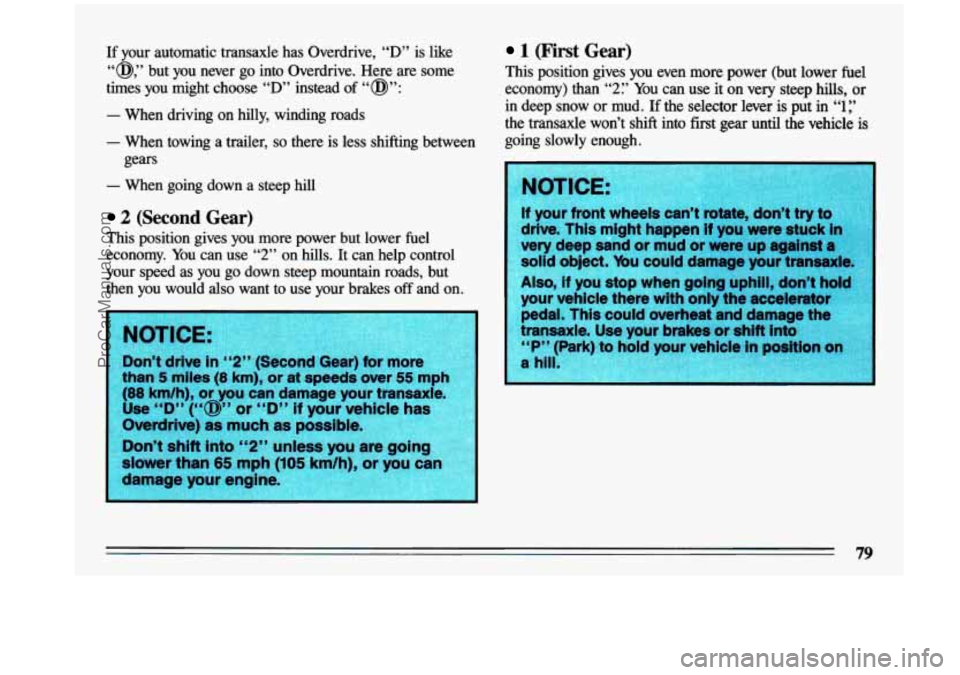
If your automatic transaxle has Overdrive, “D” is like
“a,” but you never go into Overdrive. Here are some
times you might choose
“D” instead of “@”:
- When driving on hilly, winding roads
- When towing a trailer, so there is less shifting between
gears
- When going down a steep hill
2 (Second Gear)
This position gives you more power but lower fuel
economy. You can use
“2” on hills. It can help control
your speed as you go down steep mountain roads, but
then you would also want to use your brakes off and on.
1 (First Gear)
This position gives you even more power (but lower fuel
economy) than 2. You can use it on very steep hills, or
in deep snow or mud. If the selector lever is put in “1 i’
the transaxle won’t shift into first gear until the vehicle is
going slowly enough.
bb 99
79
ProCarManuals.com
Page 82 of 324
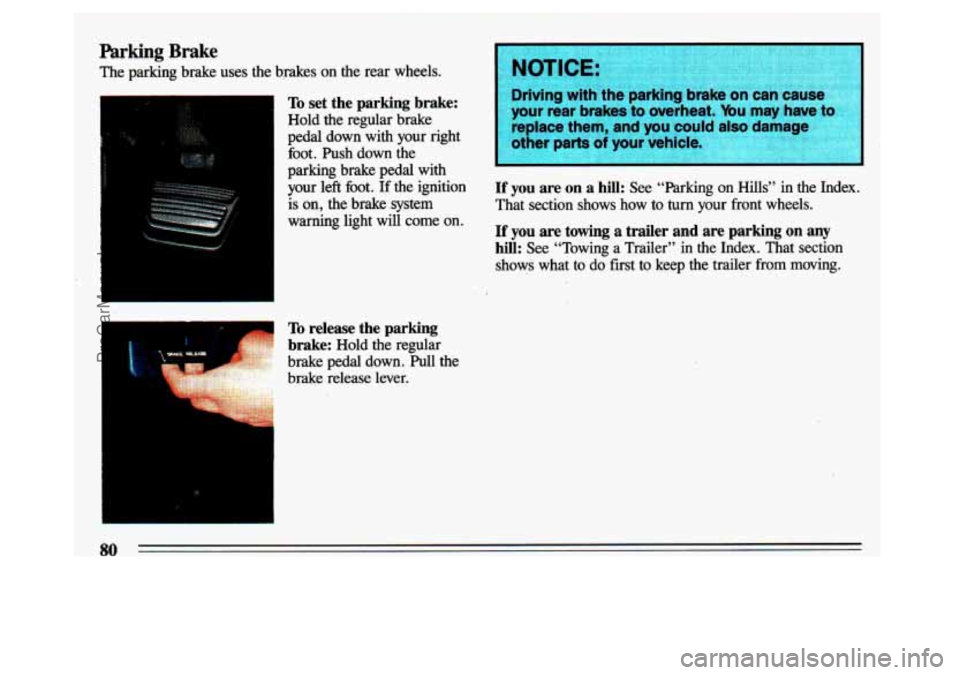
Parking Brake
The parking brake uses the brakes on the rear wheels.
I
To set the parking brake:
Hold the regular brake
pedal down with your right
foot. Push down the
parking brake pedal with
your left foot.
If the ignition
is on, the brake system
I warning light will come on.
L
I
To release the parking
brake:
Hold the regular
brake pedal down. Pull the
brake release lever.
NOTICE:
Driving with thiparl ‘g brake or )use
your rear brakesto oveFheat. ybu may have
-
replace them, and you could alse damage
other parts
of your vehicle.
If you are on a hill: See “Parking on Hills” in the Index.
That section shows
how to turn your front wheels.
If you are towing a trailer and are parking on any
hill: See “Towing a Trailer” in the Index. That section
shows what to do first to keep the trailer from
moving.
80
ProCarManuals.com
Page 93 of 324

Cruise Control (option)
. .
- ~ "IWC.
. .. -
With Cruise Control, you can maintain a speed of about
25 mph (40 Wh) or more without keeping your foot on
the accelerator.
This can really help on long trips. Cruise
Control does not
work at speeds below about 25 mph
(40 Wh).
When you apply your brakes, the Cruise Control shuts
off.
A CAUTION:
Cruise Control can be dangerous where you
can't drive safely
at a steady speed. So, don't
use your Cruise Control on winding roads or
in heavy traffic.
Cruise Control can be dangerous on slippery
roads.
On such roads, fast changes in tire
traction can cause needless wheel spinning,
and you could lose control. Don't use Cruise
Control on slippery roads.
To Set Cruise Control
1. Move the Cruise Control
switch
to "ON?
91
ProCarManuals.com
Page 148 of 324
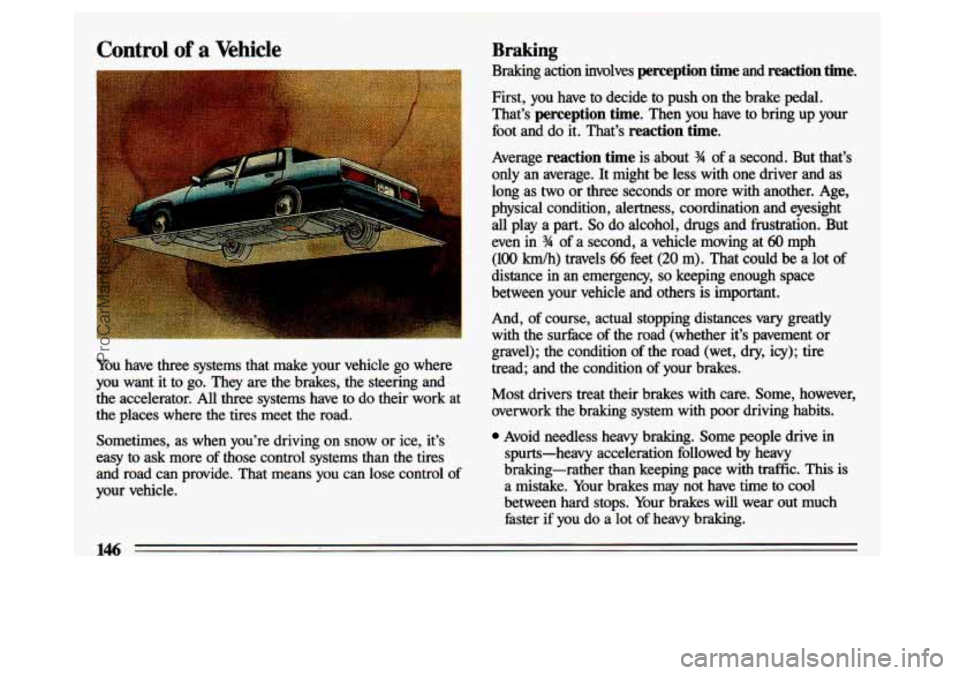
You have three systems that make your vehicle go where
you want it to go. They are the brakes, the steering and
the accelerator.
All three systems have to do their work at
the places where the tires meet the road.
Sometimes, as when you’re driving on snow
or ice, it’s
easy to ask more of those control systems than the tires
and road can provide. That means you can lose control of
your vehicle.
Braking
Braking action involves perception time and reaction time.
First, you have to decide to push on the brake pedal.
That’s
perception time. Then you have to bring up your
foot and do it. That’s
reaction time.
Average reaction time is about 34 of a second. But that’s
only
an average. It might be less with one driver and as
long as
two or three seconds or more with another. Age,
physical condition, alertness, coordination and eyesight
all play a part.
So do alcohol, drugs and frustration. But
even in
% of a second, a vehicle moving at 60 mph
(100 ludh) travels 66 feet (20 m). That could be a lot of
distance
in an emergency, so keeping enough space
between your vehicle and others is important.
And, of course, actual stopping distances vary greatly
with the surf$ce of the road (whether it’s pavement or
gravel); the condition of the road (wet, dry, icy); tire
tread; and the condition of your brakes.
Most drivers treat their brakes with care. Some, however,
overwork the braking
system with poor driving habits.
Avoid needless heavy braking. Some people drive in
spurts-heavy acceleration followed
by heavy
braking-rather than keeping pace with traffic.
This is
a mistake. Your brakes may not have time to cool
between hard stops. Your brakes
will wear out much
faster
if you do a lot of heavy braking.
146
ProCarManuals.com
Page 149 of 324
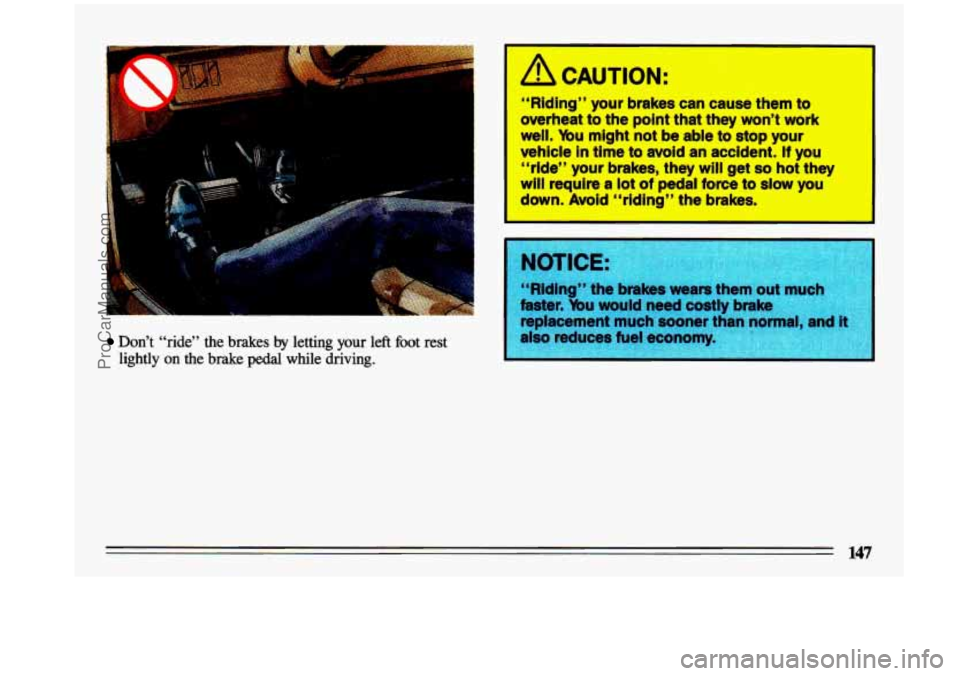
Don’t “ride” the brakes by letting your left foot rest
lightly
on the brake pedal while driving.
“Riding” your brakes can cause them to
overheat to the pointthat they won’t work
well. Mu might not be able to stop your
vehicle In tlme to avoid an accident. If you
6crlde” your brakes, they will get 80 hot they
will require a lot of pedal force to slow you
down. Avold “ridlng” the hralaas.
faster. vou would need cos
replacement
much sooner
also reduces fuel economy.
147
ProCarManuals.com
Page 150 of 324
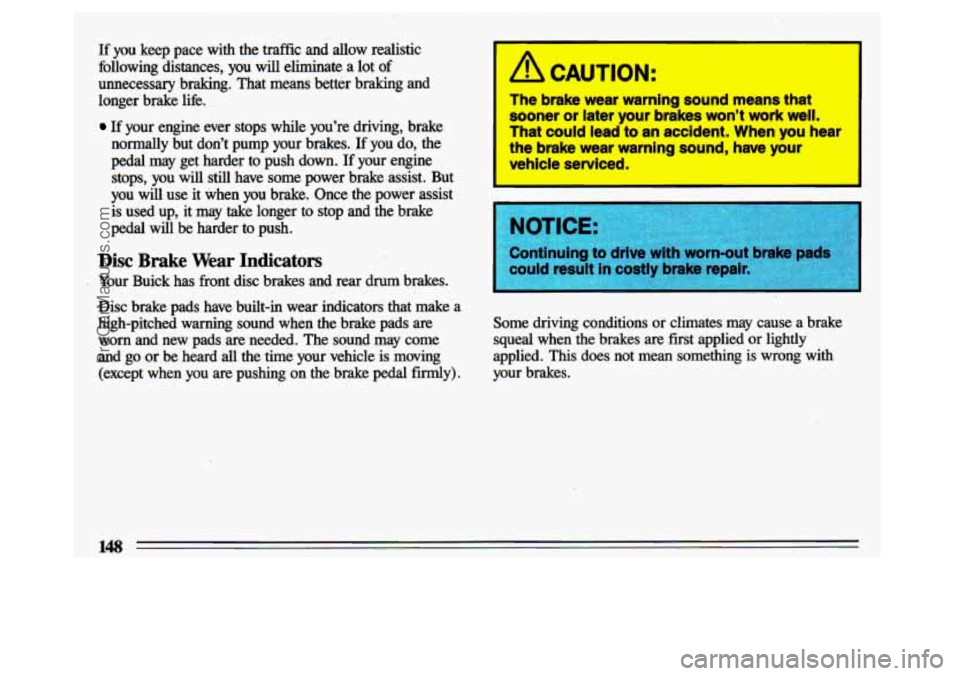
If you keep pace with the traffic and allow realistic
following distances, you
will eliminate a lot of
unnecessary braking. That means better braking and
longer brake life.
If your engine ever stops while you're driving, brake
normally but don't pump your brakes. If you do, the
pedal may get harder
to push down. If your engine
stops, you will still have some power brake assist. But
you will use it when
you brake. Once the power assist
is used up, it may take longer to stop and the brake
pedal will be harder to push.
Disc Brake Wear Indicators
Your Buick has front disc brakes and rear drum brakes.
I A CAUTION:
The brake wear wamlng sound means that
sooner or later pur brakes won't work well.
That could lead to an accident. When you hear
the brake wear warning sound, have your
vehlcle serviced.
I
Disc brake pads have built-in wear indicators that make a
high-pitched warning sound when the brake pads are Some driving conditions or climates may cause a brake
worn and new pads
are needed. The sound may come squeal when the brakes are first applied or lightly
and
go or be heard all the time your vehicle is moving applied. This do\
es not mean something is wrong with
(except when you are pushing on the brake pedal firmly). your brakes.
ProCarManuals.com
Page 151 of 324
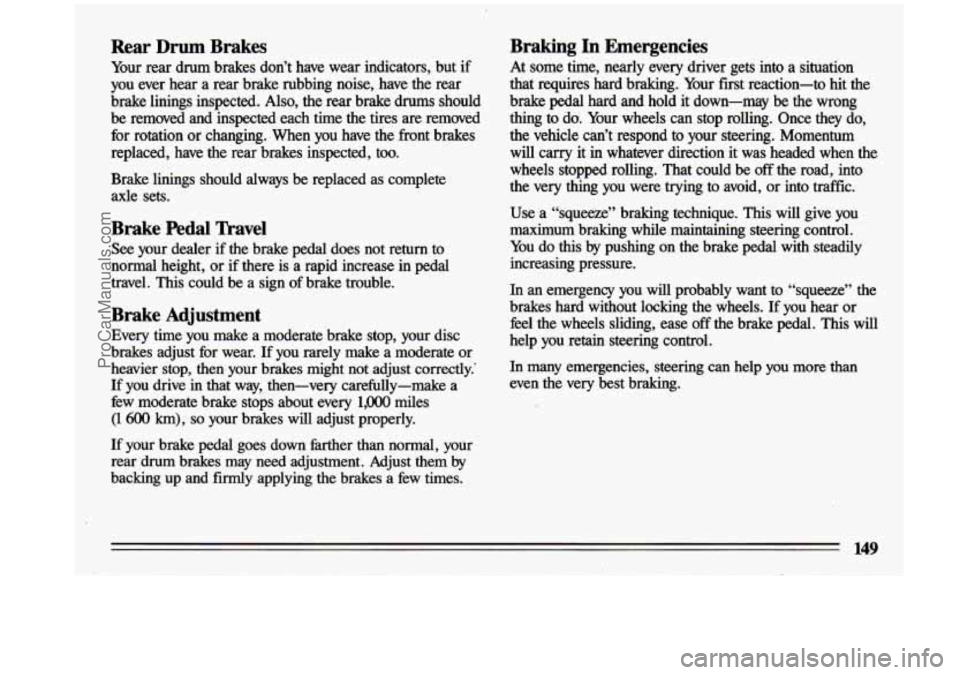
Rear Drum Brakes
Your rear drum brakes don’t have wear indicators, but if
you ever hear a rear brake rubbing noise, have the rear
brake linings inspected.
Also, the rear brake drums should
be removed and inspected each time the tires are removed
for rotation or changing. .When you have the front brakes
replaced, have the rear brakes inspected, too.
Brake linings should always be replaced as complete
axle sets.
Braking In Emergencies
At some time, nearly every driver gets into a situation
that requires hard braking. Your first reaction-to
hit the
brake
pedal hard and hold it down-may be the wrong
thing to do. Your wheels can stop rolling. Once they
do,
the vehicle can’t respond to your steering. Momentum
will carry it
in whatever direction it was headed when the
wheels stopped rolling. That could be
off the road, into
the very thing you were trying
to avoid, or into traffic.
Use a “squeeze” braking technique. This will give you
maximum braking while maintaining steering control.
You do
this by pushing on the brake pedal with steadily
increasing pressure.
Brake Pedal Travel
See your dealer if the brake pedal does not return to
normal height, or if there is a rapid increase in
pedal
travel. This could be a sign of brake trouble.
Brake Adjustment
Every time you make a moderate brake stop, your disc
brakes adjust for wear.
If you rarely make a moderate or
heavier stop, then your brakes might not adjust correctly.’
If you drive in that way, then-very carefully-make a
few moderate brake stops about every
1,0oO miles
(1 600 km), so your brakes will adjust properly.
If your brake pedal goes down farther than normal, your rear drum brakes may need adjustment. Adjust them by
backing up and
firmly applying the brakes a few times. In an emergency you will probably want
to “squeeze”
the
brakes hard without locking the wheels.
If you hear or
feel the wheels sliding, ease off the brake pedal. This will
help you retain steering control.
In many emergencies, steering can help you more than
even the very best braking.
149
ProCarManuals.com
Page 152 of 324
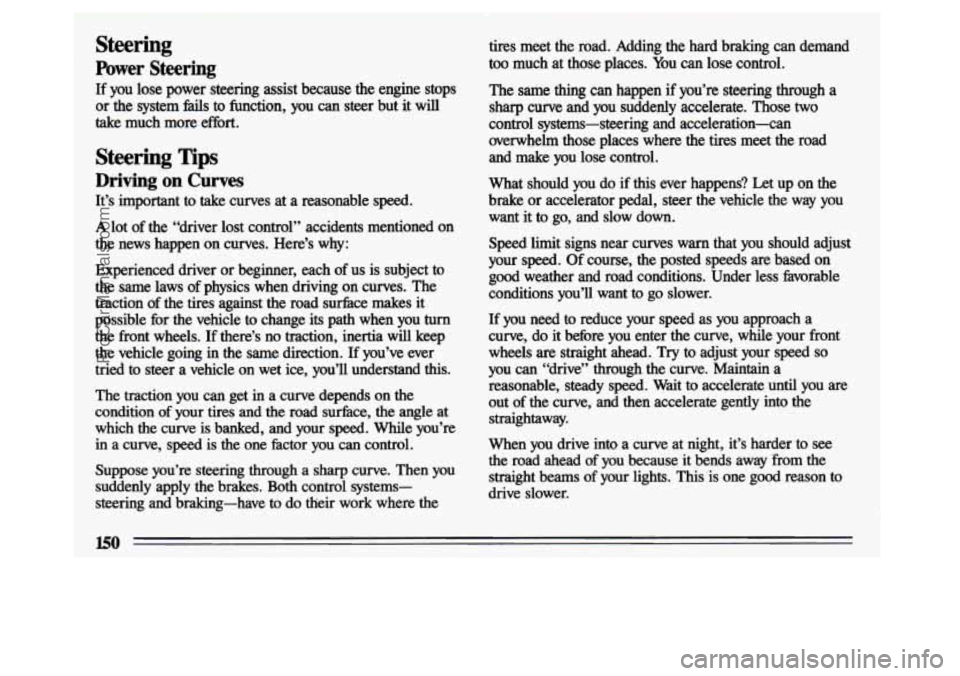
Steering
Power Steering
If you lose power steering assist because the engine stops
or the system
fails to function, you can steer but it will
take much more effort.
Steering Tips
Driving on Curves
It’s important to take curves at a reasonable speed.
A lot of the “driver lost control” accidents mentioned on
the news happen on curves. Here’s why:
Experienced driver or beginner, each of us is subject to
the same laws of physics when driving on curves. The
traction
of the tires against the road surface makes it
possible for the vehicle to change its path when you turn
the front wheels. If there’s no traction, inertia will keep
the vehicle going
in the same direction. If you’ve ever
tried to steer a vehicle on wet ice, you’ll understand
this.
The traction you can get in a curve depends on the
condition
of your tires and the road surhce, the angle at
which the curve is banked, and your
speed. While you’re
in a curve, speed is the one factor you can control.
Suppose you’re steering through
a sharp curve. Then you
suddenly apply
the brakes. Both control systems-
steering and braking-have
to do their work where the
tires meet the road. Adding the hard braking can demand
too much at those places. You can lose control.
The
same thing can happen if you’re steering through a’
sharp curve and you suddenly accelerate. Those two
control systems-steering and acceleration-can
overwhelm those places where the tires meet the road and make you lose ‘control.
What should you do
if this ever happens? Let up on the
brake or accelerator
pedal, steer the vehicle the way you
want it to go, and slow down.
Speed limit signs near curves warn that you should adjust
your
speed. Of course, the posted speeds are based on
good weather and road conditions. Under less favorable
conditions you’ll want
to go slower.
If you need to reduce your speed as you approach a
curve, do it before you enter the curve, while your front
wheels
are straight ahead. Try to adjust your speed so
you can “drive” through the curve. Maintain a
reasonable, steady speed. Wait to accelerate until you are
out of the curve, and then accelerate gently into the
straightaway.
When you drive
into a curve at night, it’s harder to see
the road ahead of you because it bends away .from the
straight beams of your lights.
This is one good reason to
drive slower.
ProCarManuals.com